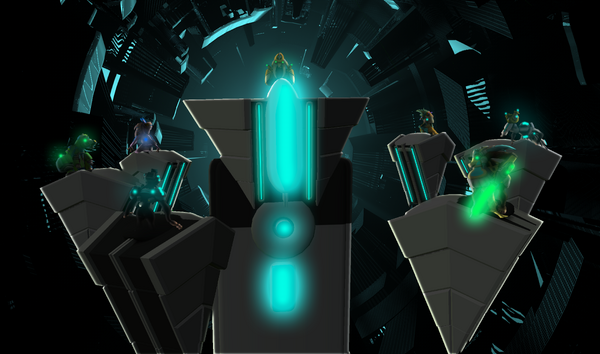“A monument to all psionics. A bastion for those in need. The bane to all evil in the Universe.”
- - An Historical Dossier
The Intergalactic Psionic Pact, Psionic Alliance Pact or more commonly and officially known as the Singularim Pact is a galactic hegemony located in the Chandras Galaxy, being the largest organization in its galactic community. Thousands of civilizations pledge for the protection of Singularim law, led by a military junta and designed first and foremost to protect its members from external threats.
The Singularim Pact is the political brainchild of one particular entity: Singul'Aren. The Pact was first conceived as a revolutionary movement seeking to challenge the rule of the then superpower known as the Xol Dominion circa 2790. The war for liberating Chandras from the iron rule of the Xol'Etra escalated into a conflict that saw many parts of the galaxy devastated and several planets devoid of life. The revolutionary army of the Singularim was able to push the Xol Dominion away from the alliance's member states and deplete most of its military assets.
With the expansion almost reaching its end, Singul'Aren retreated as leader of the revolutionary movement and allowed the Singularim Pact to evolve as it needed to fulfill its ultimate goal of becoming protectors of the universe. During the Cold War, the Singularim Pact saw strong reforms in its command structure, relinquishing its authority over the member states and remaining as a military alliance just like its old predecessor: the Cianju Alliance.
Destined to only enact its legislation when in moments of crisis or joint operations, the Pact still consolidated an immense Sphere of Influence thanks to some of its founding members who already upheld a level of a hegemonic power in the Chandras Galaxy, such as the Tyr Empire or the Xochi Trade Empire, which provided with manpower, economy, and industry for the Singularim to field its fleets and joint operations. For instance, the Pact immediately sought to expand its sphere of influence through the Quadrantia Wormhole stationed in the outer rims of the galaxy, coming to aid the Rambo Loyalist forces, participating in the subsequent liberation of Serindia space, and becoming key participants in the liberation front of the New Cyrandia Republic in the Cyrannus Galaxy.
Despite the formation of enclaves on other galaxies that would expand Singularim influence, the military alliance, founded under the banner of the Krassio Mandate's military power, would begin to slowly crumble upon the weight of several factors a hundred years following its formation. As its members enjoyed almost complete autonomy over their borders, members such as the Tyr Empire and the Ramion Concordat quickly rose in terms of military power and tensions between them were high. A combination of foreign invasions, internal divisions, and the inability of the Krassio to maintain their projection of power led to the dissolution of the Pact, leaving the galaxy greatly fractured between three powers.
History[]
Revolutionaries[]
The sparks of what would be called the Singularim Pact first appeared during the era of the Xol Dominion, a psionic empire ruled by the psionic spirits called Xol'Etra in the absence of the late Krassio Host. The Dominion ruled with an iron fist, and there was no chance for democratic forms of government to arise in Chandras at that time. Although there were Krassio in Chandras, they were subjected to horrid treatments by their psionic overlords, such as oppressive legislation upon the Krauna Civatrons and the extinction of the Livirkitons, Inog and Khalinar species of the Krassio. Only the Tyr Empire and the Xochi Trade League had managed to stay out of the Dominion's rule, as well as the Loron.
When Singul'Aren arrived with the forces of the Beacon Sector in order to wage war against the oppressive rule of the Xol Dominion, many peoples, such as the Pard Polity, the Ramion Concordat, and the Tukatra Combine saw a chance at breaking the yoke of the Xol'Etra, joining the Krassio, Tyr and Xochi revolution. With the galaxy polarized by a cosmic wind of freedom, the Xol Dominion and the newly arisen Singularim Pact led by Singul'Aren clashed in the opening stages of the Great Psionic War.
Great Psionic War[]
The Great Psionic War is mythic in nature and many of its narratives and testimonies are considered to be very much galvanized and poetically enhanced to add a mystic and glorious tone. Many of these records are in fact stories collected from numerous civilizations that suffered the collateral damage of the war.
From all of the collective literature and media related to the war, it is known that, at first, the Singularim Pact suffered the full brunt of the Dominion armada. The militia recruited by the Pact confronted the Xol'Etra's indoctrinated troops and psionic forces across the Ynura and Kapogeum Sectors of the galaxy. Although they suffered a series of defeats against the Dominion's hardened leaders and crushing presence of the Xol'Etra's psionic might, the Pact won a decisive victory that halted the Dominion advance during the Battle of the Ixochi Tradeline, which provided substantial weaponry to the Pact and crossed three different sectors. By defending it, the Pact managed to prolong their cause and acquire a better strategic position.
The Pact gained the upper hand against the Dominion when a covert operation led by the revolutionists managed to awake a dormant Krassio fleet simply called the Primal Armada, waking, in turn, the legendary Krassio Host leader Master Kroc. The battle-hardened elite forces of the Primal Armada replenished the vigor of the revolution. A second event, the birth of the psionic goddess of Death, Ynur'Vae, created an overwhelming front against the Xol Dominion, which already suffered from a coup d'etat by the forces of Didact Ur'bos.
The Great Psionic War ended during the siege of Vof Valar, the megastructure that served as a center of governance, command and economical administration for the galaxy since the times of the House of the Krassio. The Pact's fleets bombarded and fought the valiant defenders of the Dominion. After 10 months of constant fighting (or so the stories say), the conflict ended abruptly when an alien force called the Yasuul Legion appeared from a dimensional rift from the Mirror Universe, invading Vof Valar and infesting it with psionic aberrations. The Xol Dominion, with its forces, depleted and with now Didact Ur'bos as the supreme leader of the Dominion, called in a cease-fire and was forced to recognize the independence of the Singularim Pact's member states.
Cold War and Reforms[]
What followed was a tense cold war between the now free nations in Chandras and the still loyal subject empires of the Dominion. Despite technically achieving their goals, the Singularim Pact was not dissolved due to the present danger of the Yasuul Legion, which slowly but steadily began occupying neighboring worlds, and the still imposing forces of the Xol Dominion (which were quite substantial and enjoyed far better logistics). However, the Singularim Pact was dissolved from being a nearly autocratic revolution force led by Singul'Aren. The idealistic leader of the Revolutionists stood down, refusing to remain as leader, and instead focused on his true directive, the teachings of the Psionic Arts as a God of Balance. Master Kroc, however, conducted these reforms in the revolutionary army. He sent all forces back to their home territories and allowed the member states to select the form of government the Pact would now have. The Pact was transformed into a military alliance that would also oversee peacekeeping missions across the galaxy, start economic and infrastrcuture re-growth plans in war torn sectors, facilitate cooperative expeditions into extragalactic affairs by member states, and ultimate protection from hostile and expansionist foreign powers. The Singularim Pact established a Triumvirate Military Junta and a minor assembly called the War Assembly of Worlds to oversee such matters. Master Kroc was appointed as Commissary-General of the Pact, replacing and ruled the alliance with Emperor Xindrox of the Tyr Empire and Chancellor Ixchel of the Xochi Trade Empire.
The Cold War ended with the Pact, the reformed Xolarum Republic and the Lankrass Alliance signing the Treaty of Chandras, where they agreed for military and resource aid in times of Crisis and recognized each other as nations in the same galaxy with the purpose of working towards peace. The Pact remained as the largest faction in the galaxy, controlling at least half of it on the Galactic West. For many, it was called the Power of the West, a mirroring nod to the late and legendary Cianju Alliance, which was called the Power of the East in pre-gigaquadrantic history.
The Second Great Cyrannus War[]
“We shall return to participate in the universe's fate, although this time we may be aliens to the peoples of the First Gigaquadrant and not its natives.”
- - Grand Maester Kroc.
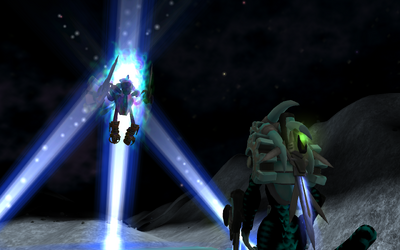
Ynur'Vae resurrects Bo Ramik for the glory of the DCP.
Ynur'Vae, the Krassio's main military commander, inspired by her friend Kroc, took an interest in liberating the former Rambo Nation sectors of Quadrant 82, from the Galactic Empire of Cyrannus where the Civatrons' former allies lie. For a time, she observed all the different events in the massive conflict and deemed the Empire as a threat to the Pact's own agenda. Prompted by DCP Emperor Wormulus II, Ynur'Vae resurrected the DCP Warlord Bo Ramik to help on the war effort indirectly, but in the end she determined that no troops would cross unto the other side.
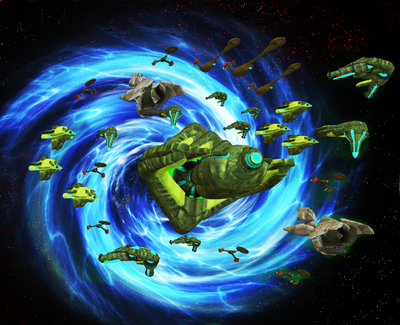
The 7th EF of the Pact marked a historical event as the Civatrons introduced themselves back into the larger community of the First Gigaquadrant.
Seeking to aid their ancient allies in their struggle for retribution and reform, the Pact, under the direct orders of Archon Xindrox, advanced through the Quadrantia wormhole into the larger galactic cluster with a large fleet and army in order to support the Rambo war effort against the Empire. Named the 7th Expedition under the leadership of Lord Psantik, the Pact's forces pierced through an imperial blockade poised on destroying the Rambo Loyalists for good, rescuing the Rambo forces and thus granting the Serindia a chance at their campaign to restore a Rambo based government in the quadrants.
With these events unfolding, the Pact officially declared war against the Galactic Empire of Cyrannus, allying with those it considered were the closest representations of its old alliances. Its efforts are detailed in the Operation Liberty files of the Cyrannus Galaxy and the Quadrantia records of the Rambo Liberation in their respective galaxy.
Their joint military efforts positioned the Pact as a substantial ally to extragalactic hyperpowers such as the New Republic of Cyrannus, the Delphan Coalition of Planets, and the rising Sacratus in the Quadrants.
The Next 30 Years[]
The Enclaves[]
During the next thirty years after the fall of the Cyrannian Empire as a hyperpower and, more importantly, as a perceived threat to Singularim's members, the Pact enjoyed freedoms from foreign powers to further its growth by establishing colonies that would become enclaves. The Singularim received petitions from small psionic worlds to become enclaves, and the former's diplomats navigated the political world of foreign galaxies well. Soon, the Singularim Pact had nearly fifty colonies composed of stations and worlds that formed sixteen different enclaves in four different galaxies apart from Chandras. Three Strategos were assigned to govern and protect these outer colonies, which were cosmopolitan in nature, with no clear ethnic majority. This gradually caused an independent sentiment from these enclaves, where their Strategos struggled to maintain cohesion with the Pact for the duration of this period.
Decline of the Trade League[]
The Xochi Trade League initiated economical plans across the galaxy and the enclaves, promoting growth, but at the same time began suffering from an unknown plague suspected to have arrived from the edge of the galaxy; by the end of the first fifteen years of this period, the Xochi were desperately fighting against eldritch horrors, seeking to protect their precious dysoh spheres and dark matter processors, which would threaten the entire economy of the galaxy. The lack of Krassio intervention in this sector, and with other members worried on their own goals, the Xochi's once strong trade routes began crumbling as members nationalized and absorbed them into their territory when tensions grew larger. The Krassio did try to dispatch a force to deal with the enigmatic and abominable plague, which corrupted Xochi and other species into a blob of flesh and essence.
Tyr Expansionism[]
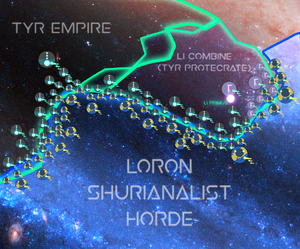
The Tyr-Loron Frontline extended about 30 thousand lightyears from the core to the outer rims at its most destructive and violent stage.
The Tyr Empire, through its expansionist agenda, annexed its protectorates and took on the Li Combine's depleted state as a protectorate. Using its forge worlds' reverse-engineered technology, they were able to build the greatest fleet the galaxy had ever seen in recent history, rivalling that of the Xol Dominion at its peak. When the Lorons, under their new and self proclaimed Big Boss Shurianali, took on the offensive seeking to break the galactic status quo, the Tyr Empire went to war alongside the Li Combine in a galactic wide frontline that continued on for 8 years. The Li Combine lost territory gradually thanks to pressures from its overlord and a slow but steady Loron advance. This feat strengthened Tyr support in the Grand Council and among smaller governments associated with the Pact, but external observers could not avoid seeing this as a more of a Tyr step up into a galactic superpower rather than truly benefitting the whole Pact.
Krassio Dissension[]
The rippling effects of the Civa Ghenes Incident continued to polarize Krassio views, as the sudden chaos incursion there was largely seen as a lack of control from their current leadership. This created a movement within the ranks of the Singularim loyalist Krassio, called Ascensionism; it preached on Krassio supremacy as an effective authoritarian empire over the members, which were seen as subjects by these new proponents. The incursion of chaos monsters and cultists continued to cause damage in the regions of the Sanctum and the Torn of the Chandras Galaxy, where constant battles were fought, with the Krassio Mandate actively seeking to destroy the source for these thirty years, to little gain. This further weakened its position within the Pact, as other members, once deterred from internal conflict and tension by the Krassio's projection of power, began an arms race to compensate from the lack of Krassio presence while dealing with demonic threats, the Xochi's continued decline with the plague, and the Tyr's rise of military might.
The Upheaval[]
The year NE 56 marked the start of the Chandras Upheaval, from which the Singularim never recovered. Contributing factors included increasing dissension among the Krassio and their overall failure to serve as an effective deterrent among the members of the Singularim Pact's bitter rivalries; the reformation of the Kandrraz Bandz into a full-fledged nomadic empire; Tyr's over-extension of its borders and military hyper-industrialization; and the full-scale invasion of the Maelstrom essentials on the edge of the galaxy.
The war is generally considered to have begun in the month of Iunuis, NE 56, when the Ascendancy, under High Judicator Inujev, betrayed the Mandatist forces at the battle of the Torn against Chaos forces, presumably killing Anur'Ctar (Master Kroc), which sent ripples of chaos across the galaxy. This sparked the civil war the Krassio Mandatists had been desperately trying to avoid among their ranks and dissolved any form of a chain of command the Singularim Pact had under Kroc, prompting Xindrox to declare himself the new Singularim Commissary-General and rebranding it as the Hegemony. The Ramion Concordat and the Pard Polity immediately withdrew from the martial alliance and pledged themselves to the Mandatists as they braced themselves for the coming storm. The Xochi Trade League, after years of dealing with maelstrom-based diseases and corruption in their worlds, finally collapsed when the Malakhim launched their invasion through a portal at the edge of the galaxy. Goddess of Death Ynur'Vae faced Nod-Tehom, ending with both deities being sealed away in a dormant state. By the end of the first Maelstrom-Psionic conflict in the region of the Ambit, the Ascendancy already controlled most of the Krassio Mandate's territory, and the Hegemony of the Tyr had won significant battles against the Ramion and Bard, as well as maintaining a foothold against the Loron advance with the help of two Krass forges the Tyr had managed to re-activate. The Metruia Enclave, led by united and still loyal Singularim forces, provided a much-needed buoy for the Mandatist forces during the entire war, as well as the support of the Cybianian Empire as a major relief force for the battered Li Combine. The Battle of Li Primus was a concurrent event to the Battle of the Torn, where the Dazok Empress Leyra would (through aid from Li Prime Minister Hogrom) assert her will and fight alongside her forces to allow the Li Exodus to the Eracleya Galaxy.
By Neochios, NE 58, the Krassio Ascendancy led its forces in the Siege of Praxeum, opening the most brutal theatre of war ever seen in Chandras or any psionic user, as the Psionic Lords engaged in their civil war's most critical battle with no restraint, ripping apart the fabric of space and time and causing cascading dimensional rifts and waves of gravitational anomalies as the Iluvii Realm shattered under the two divergent factions' savage fight. The Battle of Praxeum lasted the final two years of the war, with its climax including forces such as the Dark Psionic Lords emerging to defeat the Allfather, Singul'Aren, the Pharia's devoured souls facing Ynur'Vae's Doted spirits, and the Iluvii loyal to Kraitoss and the Archspirits facing the dark psionics of the Lankrass.
The war concluded almost simultaneously with the death of the Allfather and most of the Iluvii gods in general, prompting the retreat of remaining Iluvii spirits from Chandras and closing all portals to the Iluvii Realm to try and heal it from the massive wounds; the Tyr Hegemony pushing the remaining Mandatist forces from Chandras and consolidating its new gains, collapsing the Chandras-Quadrantia wormhole from their end with micro-cosmic vector foils; and the Nuvaio Swarm beginning its slow claim over the Loron territories.
The political alignment and social structure of the galaxy were changed following the Chandras Upheaval and the fall of the Singularim Pact. Unlike the Pact, a peacekeeping force against Chandras' already deteriorated state, the galactic order saw the rise of three highly expansionist and belligerent superpowers enhanced by the Krass' technology or by essence technology. The Ascendancy, the Hegemony, and the Swarm emerged as rivals, following a de-escalated but still violent war of attrition among them called the War of the Three Thrones. The presence of Virgonian choir of spheres left some to wonder whether they would become a fourth power in the galaxy, but they soon added their strength to the Swarm, as it was the most diplomatic of the three superpowers, in a mutual defense agreement unofficially called "Nuvaoi-Virgo Pact"
In the wake of Singularim devastation, the Metriua Enclave was left as its sole remnant, now the safe haven of millions of refugees. Its leaders, Lord Psantik, Val'Dir, Master Bel, Izel, Queen Prashlyn, President Barroco, and Sister Itzcoatl convened to plan their next move, as the Metruia Enclave's surplus of refugees was re-organized as the Tigris Pilgrimage Force (TPF), looking to establish a new home for the survivors of the war in a three-stage exodus. In the eyes of many of its old allies, the TED was the Singularim's provisional government as it evolved into something more stable.
Politics[]
While seen as a strong military, economical, and religious alliance by foreign powers with a clear leadership and infrastructure, the Pact has always suffered from a de-centralized military and economy, using only outward expansion and unilateral defense as its means to unite its members. When it came to creating a nationalistic sentiment or sense of unity as a single body among its member-states, the Pact continuedly relied on the Pact's main founders, the Krassio Mandate, to control and keep its members in check. This was partly to the Krassio's philosophical viewpoint of ecologism, which defines a territory as a breathig, living ecosystem with its own trophic levels, positioning the Psionic Lords as the Alpha Predators, or Wardens of their perceived territory. This political viewpoint saw erratic interventionism in Pact affairs and lack of centralization on their part. Many times did the Grand Council call for a unification under the Krassio in a similar way the Krassio Host had worked. However, these petitions were denied, as the Krassio Host existed as a military machine of galactic industrial proportions to sustain the conflict against the forces of Chaos. This lack of usual control over an organization further allowed other powers to take the stage. Currently there is a tense cold war between the Ramion Concordat and the Tyr Empire, whoe territories lie on opposite sides of the galaxy. The Ramion and Tyr engage on proxy wars with their protectorates, prompting civil wars and coups to further advance their goals.
Governance[]
Court of Three[]
As a Military Junta, the Pact is ruled by a board composed of the highest-ranking individuals in the chain of command, effectively turning it into an oligarchy where only the founding members are allowed to lead the alliance. Although each of the Pact members manages and rules their territories separately, it is the Court of Three that truly holds ultimate authority in the true sphere of influence of the Pact, policing and protecting its 'perceived borders'. The Court of Three is also used for political benefit and influence among the different nations, as they pursue legislations that are heavily supported by the Grand Armies of the Pact. Despite their role being almost exclusively militaristic, the Court of Three is regarded as the ultimate authority for many of the Pact's citizens and their official delegates before extra-galactic affairs. The oligarchic government is led by a Commissary-General, a High Commissioner, and an Archon, which fulfill different roles for the Junta:
- Commissary General: The head of the oligarchy known as the Grand Council that dominates the Singularim Pact—composed of all six founding members. The Commissary-General leads council meetings in search of a better diplomatic relationship among the different states. The Commissary General also heads the diplomatic affairs of foreign relations. This position allows the holder access to special veto powers, such as the right to call on an emergency meeting of all founders, declaring war, and even deposing councilors from the board.
- Archon: The head of all armed forces delegated to the Pact for joint expeditions and defense fleets. It is the Archon who seeks to assert the Pact's military dominance over the Chandras Galaxy, and even outside the galaxy, such as the Endless Space, the Quadrantia galaxies, and the Cyrannus Galaxy. The Archon manages and deploys the Grand Armies of the Pact as he sees fit, advised by a Cabinet of Joint Chiefs composed of generals and officials of all of the founding member states. The Archon has ultimate authority over the military when at war, and on such occasions, the holder's power rivals that of the Commissary General in terms of political influence.
- High Commissioner: The Head of all trade and administration of assets. The High Commissioner is tasked with securing above-average solvency for the Pact in order to ensure its military operations and the sustenance of its large-scale conflicts. The High Commissioner also has the authority to sanction its members or to engage in economic conflicts with foreign states to ensure the survival of the Pact's assets and capital. This position might look smaller compared to the other two, but make no mistake, for the veto powers conveyed to the High Commissioner allows the holder to severely sanction founding members, protectorates, or other smaller empires, preventing them from accessing the enormous wealth accumulated from the galactic contributions of half Chandras and beyond. A single economical blow to a founding member could cripple its economy forever, and that is a fact no one can ever ignore.
Grand Council[]
Below the Court of Three's administration, the Grand Council takes center-stage, in which all of the founding members of the Pact participate in and hold permanency. In order to be part of the Grand Council, a nation or a state wishing to join must hold considerable military assets, honoring the fact that the Pact is foremost a military hegemony. Due to the elitist nature of the Grand Council, the government is considered to be highly autocratic, with stronger empires imposing legislation and reforms on other, much smaller nations with little saying in governance and military action. The members of the Grand Council are elected Councilors representing their own government, which in turn is in control of a certain portion of Singularim space holding other, minor empires. Each Councilor has the responsibility to watch for the interests of its own government and assigned protectorates.
Although each member of the Pact holds a degree of hegemony over their protectorates, the councilors cannot call for emergency meeting sessions, as it is a veto power conceded to the Commissary-General, nor they can overrule edicts from other council members over their respective assignees. So even if the Ramion Concordat would often disagree with the Tyr-Tukatras slaving policies, they can only try and confront them at the board.
Competition and steady alliances between councilor species have been present since the inception of the military junta. While the Krassio Mandate and the Xochi Trade League have opted to stay neutral in the internal conflicts—the former often policing its technologically inferior counterparts—there is a present rivalry between the Pard Polity-Ramion Concordat factions and the Tyr Empire-Tukatras Combine factions, each of them representing opposing ideals in terms of governance, social structure and overall interests. This has yielded a sporadic number of skirmishes scholarly observers dub the "Proxy Wars", consisting of both sides often fighting through their protectorates and low-intensity conflicts, never confronting each other directly, as it would entail a direct face-off with the Krassio, whose advanced essence-based technology and military doctrine overrall serves as an effective deterrent to any escalation between rivals.
Despite the glorified, enhanced perception of the Grand Council's dealings, in truth, they rarely hold meetings due to the Krassio Mandate's effective military policing over the galaxy (mainly executed through psionic wards across the galaxy) and the well-established bureaucratic system—perhaps it most significant asset— based on meritocracy. This prompts the councilors to rather seek the growth of their state's political influence and military projection. For instance, the 'Iluviianfall plan' is a protocol drafted by the Bard and Ramion governments that details the constant upgrade and maintenance of a substantial force that could defend themselves against a potential Tyr invasion in the event that the Krassio's forces are no longer able to project their power in a pragmatic way. This has created an underwater arms race between both sides.
Members[]
“The Universe will be safe under our watch.”
- - Popular Krassio saying
The Krassio Mandate is where the colonized settlements of the Krassio dwell, it is the galactic space that the psionic lords claimed for themselves and from where they expand their hard and soft power across Chandras, influencing the Pact's other members directly and threatening with their imposing fleet the neighboring powers. The Mandate is the center of Iluviism and the focus of the Iluvii Realm, which pours like streams of gleaming light across the entire sector. The Krassio Sanctum is center stage in religious and philosophical affairs in the entire galaxy, and it is considered a nexus of essence training and learning. As a Singularim Pact member, the Krassio have contributed the most in terms of technology, ideology, and governmental structure.
Located in the galactic North of Chandras, it is the second-largest nation in the Pact. It holds strategic resources and military assets, such as the Wormhole to the rest of the Quadrants or possessing the most powerful elite forces known in gigaquadrantic history, the Civatron warrior tribes.
The Krassio Mandate is a theocracy, ruled with absolute authority by the Trinity of the Psionic gods. The Sanctum's positioning in the Pact is key not only to the fact that it holds the greatest religious center in the galaxy, but that its leader, Grand Maester Kroc, is also the Commissary-General of the entire Singularim Pact. Moreover, their great pre-historical ancestry and great supernatural power make them the ideal candidates for leading a Military Junta of such magnitude.
The Mandate is not restricted to Chandras like its fellow members. It is said that the Krassio inhabiting Chandras are merely a representation of the broader empire they cast their light upon, as Krassio members come and go from the Space in Between and Chandras. The Singularim Pact is just but one of the many hands the Mandate expresses throughout the universe and for the First Gigaquadrant, they chose the Pact.
Protectorates
- Nahuan Polity
- Xol Iluviist Order
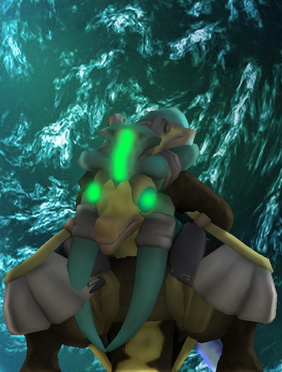
Mayor Dersan is the Councilor that represents the Krassio Mandate.
“Our belligerent nature has secured our existence throughout this galaxy's violent history!”
- - Emperor Xindrox
The Tyr Empire is a civilization native to the Chandras Galaxy, which rose to prominence following the War of Ages in the galactic south. Its nationalist identity and their fervent devotion to the Imperial Throne allowed them to build an effective military infrastructure, conscripting most of their population and asserting dominance over other civilizations, which were later used as a labor force to manufacture great amounts of weaponry and machinery to support their conquest efforts.
In a few strategic skirmishes that secured old Krassio technology from the Xol Dominion, the Tyr Empire managed to boost their technological advances, plus large deposits of spice and other crucial manufacturing goods affirmed their position as trading partners of other economic powers in the sectors left untouched by the Xol Dominion, such as the Xochi Trade League or the Tukatra Combine. However, they were still affected by the soft power the Xol Dominion established as a superpower, policing with highly trafficked trade routes with well-equipped fleets and using their subject empire, the Li Combine, to successfully quell any expansionism the Tyr might try towards the galactic West. This created unreconciled Tyr animosity for the Xol Dominion, which in the words of their Emperor, was a casus belli in itself. The opportunity to challenge the imposing Xol'Etra came when the legendary Krassio returned from their long slumber, hailing from the Endless Space. As the Krassio challenged the Dominion for their own reasons, the Tyr joined to further their agenda of conquest and racial supremacy. When their trade rivals, the Xochi Trade League, joined the revolutionary war, the Tyr decided to deploy their troops and state their support for Singul'Aren's movement. As the Great Psionic War came to an end, the Tyr was instrumental in the creation of the Pact, with its large military assets crucially ensuring that the Pact had enough military assets to maintain stability within its members, pushing for their ruler to hold a place of strategic importance in the new alliance. When Emperor Xindrox was declared Archon of the Pact, commander-in-chief of the Grand Armies of the Pact, Tyr aristocracy, and people alike rejoiced, as this meant their militaristic efforts in Chandras would finally resonate.
The Tyr Empire is the largest nation in the Pact, holds the largest military and perhaps also the largest population. It is said that without the Krassio to successfully counter and reduce their aggressive expansionism, the Tyr would have launched massive conquests across the galaxy, with only few civilizations being able to oppose them. However, the Tyr and the Krassio get along well and hold strong diplomatic ties, one of them being similar warmongering ideologies. The Tyr Empire has been said to be a figurative foil to the political landscape in the Pact, contrasting with more diplomatic or more peaceful members like the Ramion Concordat or the Pard Polity, and generating in turn diversity of ideologies.
Protectorates
- Grenou
- Screk
- Zelvan Principality
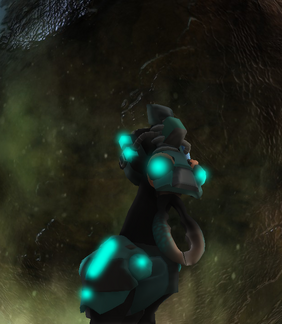
First General Didokox represents the Tyr Empire in the Grand Council.
“Unification by words is not official until all agree to speak the same language of one sole currency”
- - Common Xochi trader mantra.
The Xochi Trade League is a nation of all-female reptilian traders, made up of a myriad of merchants, corporations and guilds banded together in common commercial interests. The enormous assembly of representatives that it holds every year is led by an elected Chancellor every 20 years, a role that has befallen upon Ixchel for the last 12 years. Since its inception, the Xochi have used their innate psionic talents to persuade, control and manipulate commerce in their small corner of the Galaxy, on the edge of the Galactic North. Their aggressive capitulation of assets, goods, properties and the quick establishment of their sovereign branches across the galaxy have turned the Trade League into an economic power, despite the fact that the Xochi merely colonized a small fraction of the Galaxy. The League's real power lies in the scores of guilds that manifest their heterogeneous yet common goal of uniting all trade and commerce under their careful, ambitious watch.
When the Xol Dominion rose to galactic dominance, it represented a commercial setback for the Xochi, who considered the Dominion's imperialistic rule a hindrance to their plans. The Dominion established tight control of trade routes with the claim of protecting them of demonic or 'heretic' incursions into their reality, when most of the time they simply wanted to maintain an overwatch over potential rivals, such as the distant Xochi Trade League or the aggressive Tyr Empire. In fact, the Xochi willingly improved trading relations with long-standing rivals in the Tyr, seeking to weather the maelstrom of economic stagnancy the Dominion bore on the galaxy. When Singul'Aren's revolution struck the Dominion and further escalated into a war that would define the fate of the galaxy, the Xochi stepped in by fighting off Dominion garrisons in the main trade routes of the Galactic East, ensuring the Krassio and their allies could establish healthy supply routes for the wide frontline of the Great Psionic War. As an armistice was introduced, the Xochi pushed terms within the treaty's clauses that would ensure the safe passage of their subsidiary contractors across the detracted territory of the Dominion. The Xochi poured into their hated economic enemy like streams of water, introducing important social changes that pushed forward a reformist sentiment already growing within the populace of the Dominion and its vassal states. In a way, the Xochi Trade League was instrumental in the swift political changes that turned the Dominion into the Xolarum Republic. When the Singularim Pact officially formed, Ixchel reached the pinnacle of her career as Chancellor, becoming the High Commissioner of the Pact. The Xochi's economic solvency was, at last, safe.
The Xochi Trade League is an important member of the Pact, with its voice within the Grand Council heard by all and its insight highly valued by the Court of Three. Although the Xochi do not contribute to the Pact in a militaristic way, their wealth allows for the war machine to exist.
Protectorates
- Sapphire Star Corps
- Libdoss Guild
- Kapogeum Corpo
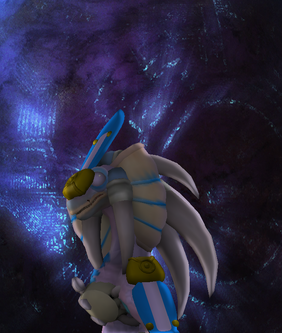
General Ijade represents the Xochi Trade League
“It is in the interest of the royal throne that Ramion spread their influence across the cosmos albeit not at the expense of the universe's freedoms”
- - Ramion Royal Speaker
Known as an oasis for those affected by Chandras's recent bloody and violent history, the Ramion Condordat is a peaceful nation ruled by an irenic monarch simply known as the Horus, to whom the Ramion revere and follow through in a religious way. Among all its warmongering allies, the Ramion is perhaps the only nation in Chandras that seeks to secure galactic peace and to influence other universal powers through the power of diplomacy, trade deals and positive relations, often advocating for the prevention of conflict.
The Concordat was under heavy influence and discrimination from the subject powers under the rule of the Xol Dominion in 2868, particularly under the pressure of the Li Combine, a military nation that continues to challenge the Ramion's interest today. When Singul'Aren's revolution shook the galaxy and embroiled into a war, the Ramion rose to arms against their oppressors, joining the revolutionaries in their crusade to liberate the galaxy from the misguided rule of the Xol'Etra, who had confiscated their worlds' resources and had condemned Ramion worship of their leader, the Horus. As their divine ruler proclaimed the canonization of the psionic all-father as a Saint of the Ramion and patriarch of the ancient way, countless more Ramion defenders rose with religious fervor against the now heretical Xol.
Today, the Ramion Concordat recognizes its peaceful ways to be influenced by their distant ancestors, the Serindia Ramboidae in the Quadrants, and although there is dissent regarding a possible origin theory in the Quadrants, many have come to accept their broader ancestry since their integration into the galactic community. The Ramion have since supported the Pact's effort to liberate Rambo as a potential ally and have sent goods to their old cousins. Some of them have even migrated to the Quadrants through the Quadrantia wormhole, and have stayed in Starbase 25 since.
Protectorates
- Gaulan Republic
- Indiso Confederacy
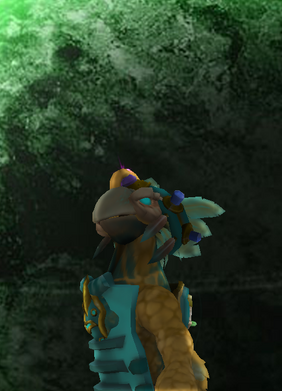
Ramix Regis represents her High King and the people of the Ramion Concordat as Councilor of the Pact.
“You condemn us for our methods? We have created the perfect intelligence machine and that allowed us to survive the wrath of those who came before you for so long. Our subjects care not for their own volitions if they affect the cause of the Combine. We are unity but through purpose, not petty individualities.”
- - Overlord Tethis to Ramix Regis of the Ramion
The Tukatras Combine is a civilization that spawned at the far galactic East of Chandras Galaxy. They are by all means an autocratic empire where only a few individuals, the leading network of Overlords, rule the rest of the population with an iron fist greatly due to their incredible intelligence agencies.
During the Xol Dominion's hegemon, the Tukatras successfully survived annexation into the Dominion thanks to their highly advanced stealth technology and agencies, which turned them into an elusive and xenophobic empire in the eyes of the Xol'Etra. However, this was far from the truth, as the Tukatras used their perceived isolationism to successfully infiltrate most of the echelons of the Dominion's society, particularly that of the Li Combine, a long-standing adversary in the Galactic West that opposed most of the powers of the East. When the Krassio revolution sparked a galactic-wide conflict, the Tukatras were of the last empires to join the revolutionist side, with their sleeper agents wreaking havoc in the Li Combine's domestic supply lines and, ultimately, critically aiding the revolution in knocking the Li out of the war and giving the Singularim revolution a chance at besieging Vof Valar. During the advent of the Psionic Cold War between the Singularim Pact and the Xol Dominion following the Vof Valar Armistice, the Tukatras' intelligence network had successfully established covert bases of operations in strategic points of the galaxy, turning it into a potential power. However, knowing that they could never match the Krassio nor the Tyr's military might, the Tukatras joined the formation of the Singularim Pact, offering their intelligence services as leverage to acquire a seat in the Grand Council, although they did not manage to gain the position of Archon, as it was given to the Tyr.
Currently, the Tukatras Combine provides intelligence and espionage assets to the Pact, their genetically engineered casts dedicated to these efforts are radical workers, who surgically perform tasks such as assassinations and power unbalances in the galaxy in order to secure the Pact's legitimacy as a galactic superpower. With the Singularim voting in favor of joining the war against the Galactic Empire of Cyrannus, some of their agents have crossed the gap between Chandras and the Quadrant Galaxies, although the nature of their mission still remains to be seen.
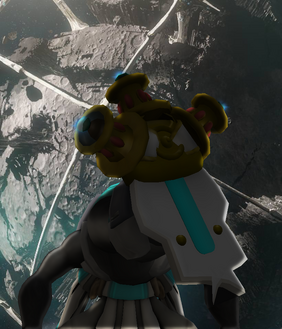
Overlord Tethis represents the Tukatras Combine before the Grand Council.
The Pard Polity is, perhaps, the most idealistic and pacifist member of all six in the Singularim Pact. Following the liberation of Pardox, which saw some of the most brutal conflicts in the Revolution of the Great Psionic War, the Pard Polity used its newly-given freedom to bring its incredible machine industry to bear on the Xol Dominion. Indeed, if one thing can describe the Pards is their affinity to connect their neural pathways and enhance them using psionic energy to handle several robotic proxies at the same time. In a process called "transduction", a single Pard can handle a full battalion of a hundred mechs, with the number of these decreasing depending on the warbot's size. Despite their incredible war machine and industrial capabilities, the Pard follow a strict code of only battling liberation wars, an opposing ideal to the aggressive expansionism of the Tyr or the ruthless conglomerate of the Xochi Trade Empire. It is said that before the Krassio or even the Xol took dominance over the galaxy the Pards had a bitter and sometimes violent rivalry with the Tukatra Combine, and that many Pards suspect the subsequent absorption of the Polity to the Dominion was led by the Combine's elusive agents. Two of these members' protectorate states are actually embroiled in a territorial dispute that is passively influenced by both powers on opposite sides. Despite Ramion and Krassio's diplomatic intervention in the situation, both nations are still embroiled in skirmishes due to the unrelenting will of its Overlords.
The Pard Polity has been active opposition to the Pact's military interventions, with Councilor Barroco condemning Tyr actions such as the annexation of the Xiox. Barroco has also criticized Archon Xindrox' decision to support the Krassio military campaign against the Galactic Empire of Cyrannus. Currently, the Pard Polity and the Ramion Concordat have pushed bills into the council to limit the Court of Three's executive actions and to shift the Pact to more egalitarian procedures to no avail.

Lord of Admiralty Barroco represents the Pard Polity in the Grand Council.
Administrative Divisions[]
The Singularim Pact holds, officially, six members that represent the bulk of the military alliance. However, these six nations, as per the Treaty of Praxeum, also absorbed the continuing protection of several minor states that did contribute in any way or the other to the Revolution War against the Xol'Etra. Each of these nations is designated protectorates, and they are to support their respective overlords in any endeavor in exchange for their safety. Historically, most of these protectorates joined under the cover the Pact in order to escape the militant order exploited by the Xol Dominion. The Singularim Pact holds then six official members and fifteen protectorates.
There were originally 16 protectorates, but this was changed after the Tyr Empire fully annexed the Xiox Clans to lay full claim to their spice deposits. In recent events, the Singularim Pact was granted access to a part of the Chandras-Quadrantia Womrhole Network through Starbase 25 thanks to its military aid of the Rambo liberation campaign.
Foreign Relations[]
The Singularim Pact has diplomatic relationships with some of the most powerful empires in the gigaquadrant in various forms, either full alliance, defensive pacts, or trade agreements. Since the Pact is considered a spiritual successor of the late Krassio Host and ultimately the Cianju Alliance, it holds recognition with its allies as it is recognized as a military power across the Gigaquadrant.

Singularim symbol, used by nations who share the same political doctrine as the Pact.
Under the interpretation of the Singularim Doctrine, the Pact has held a policy of aggressive expansion and open diplomatic relations with any empire willing to trade or collaborate with the Pact in their ongoing mission of 'protecting the universe'. The Singularim Doctrine is a philosophical and political policy with its name derived from the founder of the military alliance: Singul'Aren. It dictates political behaviors that regulate the Pact from becoming a full dictatorship or empire oppressing its members (while some of the Pact's members omit this part), as well as the level of military action and interventionism conducted by the armies of the Pact. One example is its extermination policy on demonic-based empires, as the Pact's innate power source, psionic energy, opposes demonic energy and its technology is affected by its influence. The Doctrine also holds with contempt empires that do not share their political ethics, yet are really effective at establishing a lawful order. For a time, the Pact initially sought to establish communications with the Empire of Cyrannus, seeing that its apparent order was effective. However, once it saw the atrocities committed to old allies such as the DCP and Rambo Nation, the Pact changed its intentions and sought to provide military aid to them either directly or indirectly.
Allies[]
Rambo Nation[]
In the advent of the Singularim Pact's extra-galactic relations, the Rambo loyalists to the Imperial crown Ramashe Le Rambo once held have maintained close ties with the SP. At first, the coordination between SP and Rambo loyalists was limited to Krassio military aid, as the latter had decided to help re-establish Rambo Nation as an independent state in honor of their long-standing alliance with the Le Rambo dynasty. The Singularim Pact officially established itself as an ally of the Loyalist forces by declaring the Pact in a state of war against the Galactic Empire of Cyrannus, allowing it to provide more military support to the battered forces battling in the Quadrantia galaxy.
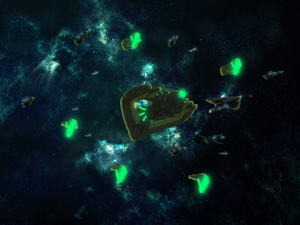
The Singularim and the Rambo have a close relationship of mutual trust and cooperation. Both nations fighting side by side during the liberation of the occupied Rambo Nation.
Since then, the Rambo have given strategic access to Starbase 25, particularly the nexus between Chandras, Quadrantia, and Tigris, giving the Pact ample territory to continue its expansion. In conjunction with Rambo Loyalist forces and the Dutch Empire, the Pact pushed a specific front through the Metruia Nebula and faced a huge Imperial defense fleet at Karzhamarhi-Nui, successfully forcing them to capitulate and joining the rest of the Loyalist forces at the Capital.
Regardless of the outcome and consequences of the Rambo fight for independence, the Singularim Pact seeks to improve its relations with whatever form of government may arise from the war, establishing trade routes and military pacts.
New Republic Remnant[]
Despite initially having a good opinion towards its counterpart, the Galactic Empire of Cyrannus, the Singularim Pact came to support the New Republic Remnant's efforts to establish their form of government into the Occupied Republic. Knowing fully well that supporting the NRR would bring the full might of the Empire to bear on the Krassio alone, the Singularim Pact officially declared war on the Empire and mobilized its forces as co-belligerents of the Remnant, seeking to establish what they now recognized as the official successor state of their old allies: the United Republic of Cyrannus. The Pact launched its forces towards Cyrannus using the Cyrannus-Quadrantia wormhole and took it for the allies, immediately deploying against the Imperial homeland and taking the Imperial task forces head-on, successfully defeating three fleets before connecting their frontline with that of the allied fleet led by the NRR.
So far, the Singularim Pact and the NRR have had cordial relations, bolstered by their mutual trust on the Rambo. However, Commissary-General Kroc has expressed interest in improving diplomatic relationships with President Apollo, who leads the resistance movement in Cyrannus.
Delpha Coalition of Planets[]
Although the relationship with the DCP has always been one of military support and joint operations during the War of Ages, the Krassio brought upon themselves to bring their new military alliance into tighter diplomatic relationships with the Plazinth hyperpower in their search for universal recognition as a sovereign state. Plans for this were executed beyond the public eye at first, with the Krassio influencing events in the very Plazinthian front of the Second Great Galactic War of Cyrannus. Honoring their previous war pacts, Kroc seeks to further their indirect relationship and common enemies into more goals that can establish order and balance in the universe. Surely, the Pact has its reservations regarding the DCP's own domestic policy (something that might be reciprocal) but they are willing to co-exist in mutual trust.
Kingdom of the Netherlands[]
During the battle of Starbase 25, the Dutch had the first contact with the Singularim Pact and secured a victory over the Empire. This marked a military alliance that followed through the final stages of the Loyalist Insurrection in Quadrant 82. Like their Rambo allies, the Singularim seek to further diplomatic relations with the Dutch as soon as the liberation war against the Galactic Empire is over. The Singularim assistance helped the Dutch to finally assert sovereignty over their shipyards and territory in the Quadrants.
Trade Partners[]
The Purity[]
As High Commissioner Ixchel opened diplomatic opportunities for trade, the Purity was one of the first to step into this offer, signing the Praxeum-Origin Entente (POE).
Military[]
The Grand Armies of the Pact are the largest armed force in the Chandras Galaxy and the second largest in the Quadrantia Galaxies. It holds a disjointed set of armies that normally band together to face a common enemy or to pursue a common goal, led by the ultimate authority of the oligarchy, the Archon. The Pact also holds the largest conscription number in the Quadrantia sub-cluster, with probably 2 billion individuals recruited annually.

The Singularim fleet amasses in Metruia, creating a staging point for their future mobilizations in the Quadrants.
The Pact holds a strategic advantage in larger extra-galactic conflicts due to the choke point that is the Chandras-Quadrant wormhole. It has never been invaded in its short history, having the opportunity to deploy their forces elsewhere several times.
Technology[]
See Neural Physics
The Singularim Pact possesses one of the most unique and highly advanced technology in the Gigaquadrant, being able to use the very psionic essence of the Iluvii Realm to power their vehicles, portals, cities, and weapons. With this in mind, their technology is often said to transcend the barriers of what is mythical and what is not. The Pact goes to great lengths to protect its technological secrets, sharing them only with empires that would join the alliance or that have impressed them.
With the Krassio joining as heads of government and spiritual leaders of the Pact, the military alliance is one of the most technologically advanced in Chandras and the entire Gigaquadrant, with insights to their technology described as being completely alien and different from other methods of scientific advancement. For instance, the Singularim Pact heavily employs psionic jump drives that allocate their ships at any point of the galaxy so as there is a psionic link to follow. The Pact makes sure it is fully connected by psi-emitters that relay pathways through the parallel dimension known as the Iluvii Realm so as to instantaneously teleport across their controlled territory. This represents a great strategic advantage for its military goals and coordination, but the fact that the need for a proxy emitter to fully reinforce positions is necessary makes the Singularim Pact a slow but powerful strategic coordinator. Despite this, their technological dependency on psionic essence makes up for this 'slow-military-progress' strategy by creating a solid and nigh unbreakable network of intelligence and coordination that creates strong frontlines, forward operations, and quick-response mobilizations.
Trivia[]
- The Pact represents The Valader's official return to wiki activities, specially fiction-wise, adhering to the First Gigaquadrant community, and therefore standing as his main fiction.
- The Singularim Pact's governmental structure is based on the Ancient Spartan League known as the Peloponnesian League, and the Russian Oligarchs that climbed to power following the Soviet Union, with military and projection of force being the key factor for the oligarchy's power instead of wealth accumulation.
- The Valader's obsession with the number three clearly pervades the entire article, please forgive The Valader for his thematic whims.

